



























Handsome 3-yearold Diesel (232735) is getting a head start on his list for Santa Paws; at the top of his list is a forever home, but rope toys are a close second.


Diesel came to us with severe skin infections, but with some TLC, this pup is now almost unrecognizable compared to the sad, itchy boy who arrived at the Lancaster Center in September. A home that can keep this stud muffin in tiptop shape and ensure he is always looking his best is a must.

With his newfound lease on life, Diesel has found himself with quite a bit more energy, so a family who can play hours of his favorite game would be perfect for this tug-of-war champion.

Please send your application to the Lancaster Center for Animal Life-Saving at adoptlancaster@humanepa.org, or give the shelter a call at (717) 393-6551 to learn more.

 By Lauren Berg
By Lauren Berg
More than 80 years later, the Dec. 7, 1941, attack on Pearl Harbor remains significant as one of only a few times the United States has been attacked by a foreign adversary on its own soil.
The tragedy of the attack came not only in the loss of over 2,400 lives, but also in how unprepared the U.S. was for it. Not that they can be much blamed; a surprise attack from a nation over 4,000 miles away had been previously unthought-of.
While much has been said about the attack itself, here are some lesser-known facts and stories surrounding Pearl Harbor:
1. Japan’s surprise attack came in the wake of a devastating American oil embargo.
In July 1941, President Franklin D. Roosevelt issued an executive order announcing a freeze on assets with Japan. Now, any business would need to seek the U.S. government’s permission to trade with the country.
However, confusion about the order resulted in cutting off all trade with Japan — including the export of U.S. oil, which the Japanese naval forces were dependent upon.
This led the island country to set its sights toward an invasion of Southeast Asia and its oil resources, though it knew such an act would lead to war against America. As a result, Japan decided to attack America’s Pacific Fleet based out of Pearl Harbor to prevent American interference in its plan for accessing the resources of these other countries.
2. Among the fallen were the remains of a baby girl.
In 1937, Chief Yeoman Albert Wagner’s wife gave birth to premature twins, one of whom died two days later. Wagner planned to scatter his daughter’s ashes at sea, storing the urn in his locker on the U.S.S. Utah.
But he never got the chance. While he survived Pearl Harbor, the daughter’s remains were lost with the sunken ship, along with the lives of 58 sailors.
A funeral was never held for baby Nancy until 2003, when her twin sister, Mary, gathered friends and family to the site of the memorial to say an official goodbye.
“I feel nothing but pride and pleasure that she’s in such magnificent company,” Mary said. “I could not ask for anything better than for her to be tenderly, carefully looked after by America’s finest.”
3. A conspiracy theory developed about newspaper ads warning of the attack.
Two weeks before the Dec. 7 attack, The New Yorker published an ad promoting a mysterious board game called The Deadly Double, which featured people in an air raid shelter playing dice — two of which were numbered 12 and seven — and included words like “alert” and “warning.”
After Pearl Harbor, people saw the ad in a different light, convinced it was a coded message to Japanese spies warning them of the impending assault.
However, the conspiracy theory was quickly debunked when it was discovered that Roger Paul Craig had indeed invented such a game and created the ads, with the numbers on the dice amounting to coincidence.
Despite its notoriety, the game never sold well, and Craig ironically ended
up working for the Office of Strategic Services — the U.S.’s intelligence agency during World War II.
4. Months later, Japan bombed Pearl Harbor again.
After the success of its initial attack, Japan began plans for bigger targets like mainland America.
But first, the military decided to do a reconnaissance flight over Pearl Harbor to see how the repair operations were going and to drop some bombs while there. Less than 90 days after the first attack, Japanese bombs once again fell on Oahu.
Fortunately, bad weather stymied the pilots’ efforts, and the bombs missed their targets, hurting no one. Though less damaging than “the date which will live in infamy,” the second attack was kept secret from the public for decades.

5. Elvis Presley helped raise money for the U.S.S. Arizona Memorial Fund.
A few years after President Dwight D. Eisenhower authorized the building of the U.S.S. Arizona Memorial at Pearl Harbor, the project struggled to raise enough funds.
Elvis Presley decided to help by putting on a benefit concert, performing classics like “Hound Dog” for thousands of fans at Pearl Harbor’s Bloch Arena.
The event brought in more than $54,000 and helped raise public interest in the memorial, which was dedicated a year later in 1962.
6. A Japanese and American soldier, both Pearl Harbor survivors, later became friends.
Zenji Abe, a Japanese pilot who dropped bombs on Pearl Harbor, didn’t learn until decades later that the attack had come before Japan’s declaration of war.
Viewing Japan’s wartime leaders’ actions as immoral, he worked to engage in reconciliation efforts between Japanese and American veterans.
In 1991, at the 50th anniversary of the attack, Abe visited the U.S.S. Arizona Memorial in Hawaii where he came to apologize to his former foes.
He found reconciliation, forgiveness, and friendship from American Pearl Harbor survivors like Richard Fiske. Fiske and Abe became close friends and agreed to honor the memorial each month with roses until Fiske’s death in 2004.
CorPor AtE offiCE
P.O. Box 8049, Lancaster, PA 17604
Phone (717) 285-1350 (610) 675-6240 Fax (717) 285-1360
Email address: info@onlinepub.com Website address: www.onlinepub.com
PrESiDENt AND PUBLiSHEr Donna K. AndersonVice
President and Managing Editor Christianne Rupp Editor, 50plus Publications Megan Joyce Art DEPArtMENt Project Coordinator Lauren Phillips By Lynda HudzickWhen the people of York hear Whistle Master Don Ryan wrapping up his yearly Christmas concert by playing “Silent Night,” they know Christmas Day has truly arrived.
For 35 years, Ryan’s father presented the late Christmas Eve performance to usher in Christmas Day. Ryan was an apprentice to his father for 35 years.
“I learned by watching him do it; that’s how I caught on.”
Because both he and his father shared mechanical and musical backgrounds, they understood not only the music but also the mechanics of the whistle, and that helped enhance their performance.
BUSiNESS
DEVELoPMENt Senior Marketing Consultant Joshua Binkley Events Manager Kimberly Shaffer ADMiNiStr AtioN Business Manager Elizabeth Duvall Member ofThe Christmas Eve concert of the historic York Factory Whistle is an annual event that has been part of Yorkers’ lives for many years and has touched people all over the globe. And it’s an experience Don Ryan and his family have been a part of for more than 65 years.

Born and raised in York, Ryan is a mechanical engineer by trade, but music has always been a big part of his life.

50 plus Life is published by On-Line Publishers, Inc. and is distributed monthly among senior centers, retirement communities, banks, grocers, libraries and other outlets serving the senior community.


On-Line Publishers, Inc. will not knowingly accept or publish advertising which may be fraudulent or misleading in nature.
Views expressed in opinion stories, contributions, articles and letters are not necessarily the views of the publisher. The appearance of advertisements for products or services does not constitute an endorsement of the particular product or service. The publisher will not be responsible for mistakes in advertisements unless notified within five days of publication. On-Line Publishers, Inc. reserves the right to revise or reject any and all advertising. No part of this publication may be reproduced or reprinted without permission of On-Line Publishers, Inc.
We will not knowingly publish any advertisement or information not in compliance with the Federal Fair Housing Act, Pennsylvania State laws or other local laws.
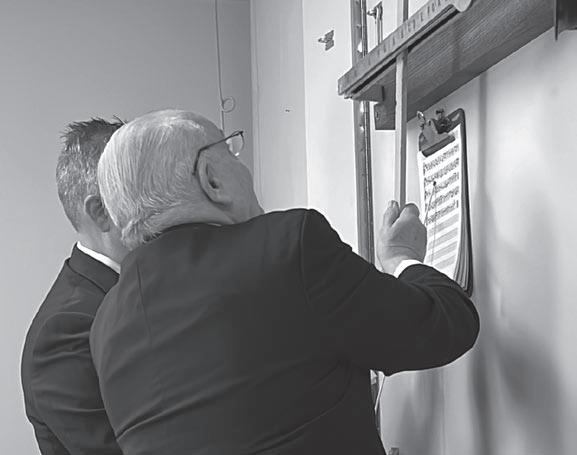
“My dad taught me how the play the trumpet,” Ryan said. “He loved music and was very talented. He was a mechanical engineer as well, but also gave private music lessons, and I do the same. I like young people, and I enjoy watching them learn.”
Ryan’s father began playing the whistle in 1955 when “a neighbor who knew Dad was into music told him about the chance,” Ryan said.
He recalls that the first song his father played on the whistle was “London Bridge,” and it was in the summer.
“My dad said, ‘I think I can make this work,’” Ryan said. “He wrote up his own music and developed the scale to play the music on. It took about seven years to develop what we have today that lets us play a variety of music in two octaves.”
Variable-pitch whistles, similar to the one Ryan plays today, were patented in 1872 and, years ago, were used all over the United States. These whistles can be heard in a 5-mile radius or even a 10- to 12-mile radius, depending on the wind direction.
Because of this, the whistles were often used to communicate with the people living close to the factory where a whistle was in operation. York’s whistle can produce sounds measuring 134 decibels, louder than a jet engine.
“It was used to announce the start and the end of a workday, to announce lunch breaks, and even to notify people of an emergency at the factory,” Ryan said.
Ryan is very knowledgeable about the history of the single- and variable-pitch whistles. He offers presentations to local organizations that would like to learn more about them, discussing single- and variable-pitch whistles and demonstrating how they are played.
Never intended to be used as a musical
instrument, the cylindrical whistle Ryan plays has existed since at least the late 1880s. It is 15 inches long and approximately 5 1/8 inches in diameter and was originally operated with steam.
“That could be a little dangerous for the person operating the whistle,” Ryan said. “It got very hot, and you would be soaked from the steam gathering in the small area where the whistle was usually installed. It was switched to compressed air in 2010, which is safer and more comfortable for the performer.”
The York whistle, currently housed in the old Metso building in York, is brass and is maintained annually.

“We have a guy who goes over it every year, tightens things up,” he said. “We do put a cover over it when it’s not in use, but you can see it from the road.”
There is a live broadcast projector on a car roof nearby that allows approximately a 20-by-20-foot projection of the whistle performance on the side of a nearby building. People can then watch the whistle during the concert, although there is a 10second delay.
Ryan and the whistle have appeared on national and international television and radio broadcasts, and thus, he has heard from people all around the globe, telling him how much they enjoy his work.
“I’ve also had my music students come in to watch and assist with the performance, and they’ve been on worldwide TV — their parents really like that,” he said.
In addition to broadcast media recognition, the whistle was listed in the 2002 Guinness Book of World Records as the “World’s Loudest Music without Amplification from a Non-Musical Instrument,” and has been featured in the National Music Museum at the University of South Dakota since 2004.
Also of note, in 2020, the whistle concert’s eighth live broadcast received 29,267,153 hits representing 104 different countries.
But perhaps more important than all the worldwide acclaim, Ryan said playing these concerts still helps him feel connected to his father and to his lifelong community.
After having been the whistle master for many years, Ryan would now like to hand the tradition down to a future generation. Although his children are interested in what he does and have assisted him in the past, they do not live in the area and so are unable to take over.
“I would like to teach someone who lives in York County who would be interested in doing it, but they have to be able to read music, and they have
WSA addresses the unique challenges that well spouses face every day. If you could benefit from this information, please join us!


Meetings held 2nd & 4th Wednesday of the month 7:00 p.m. – Wegmans, 2000 Crossings Blvd., Lancaster, PA 17601
to be willing to give up Christmas Eve to present this for the community,” he said.
For many people in the York area, this tradition has taken place annually for their entire lives.
“It makes Christmas for them; it’s so unique, and the sound is totally different from anything you’ve ever heard,” Ryan said. “I have made recordings on CD, but the sound isn’t the same as being right on top of it, hearing those Christmas carols. It touches a lot of people.”
As a way to show their appreciation for a job well done, Ryan said each year at the end of each song, “people outside lay on their car horns as a form of applause. It’s noisy, but it’s so special, everyone joining in. It’s also a chance for them to blow their horns really loud and get away with it.”
And so on Dec. 24 of this year, Don Ryan will once again don his tuxedo and head over to Arch Street to work his magic on the factory whistle, and at 12:15 a.m., he will once again usher in Christmas Day for the people of York.
“It’s something I do for my own enjoyment and the enjoyment of the community,” Ryan said. “It’s something special that I like to do for the people of York.”
on the cover: Whistle Master Don ryan, right, and son Scott, left, tuxedoed up for last year’s Christmas Eve performance of the York factory Whistle.
Almost 6 million people in the U.S. care for an ill or disabled partnerthe factory Whistle at its original site, the New York Wire Cloth Company on East Market Street in downtown York. in 2013 it moved to Metso industrial Materials on Arch Street.
Dear Savvy Senior, I’ve read that retirees will be getting a nice costof-living increase in our Social Security benefits next year, but what about Medicare? What will our Medicare Part B monthly premiums and other Medicare costs be in 2023?
– Planning Ahead

Dear Planning,
From an entitlement program standpoint, 2023 is going to be a very good year for retirees!
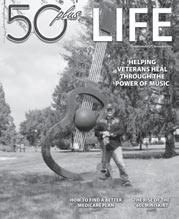
Not only will you receive a nice 8.7% cost-ofliving increase in your Social Security retirement benefits — the largest since 1981 — the Centers for Medicare and Medicaid Services also recently announced that your Medicare Part B standard monthly premium will be lowered 3% ($5.20), from the current rate of $170.10 per month to $164.90/month in 2023.
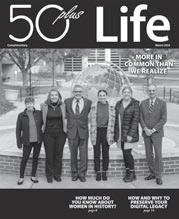

The reason for the reduction is a correction to last year’s hefty Part B premium increase, which was larger than it needed to be. The 2022 premium hike of about 14.5% was announced amid uncertainty about the potential impact of a new Alzheimer’s drug called Aduhelm, which threatened to explode Medicare costs.
That didn’t happen. The cost of the drug was cut roughly in half, from an
original $56,000 a year, and Medicare sharply limited coverage. This created a large financial reserve for Part B, allowing the program to reduce next year’s premium.
You’ll also be happy to know that in addition to the premium reduction, the annual deductible for Medicare Part B will also be lowered $7, from $233 in 2022 to $226 in 2023. And if you have a Medicare Part D prescription drug plan, the average premium in 2023 will be about $31.50, which is a 1.8% decrease from $32.08 in 2022.
But the news isn’t all rosy. The deductible for Medicare Part A (hospital coverage) per benefit period (which generally starts when you are admitted to the hospital) will be $1,600 in 2023, up $44 from this year’s $1,556.
That applies to the first 60 days of inpatient care. For the 61st through 90th day, the coinsurance will be $400 per day, up from $389 this year. And for days 91-150, the charge will be $800 per day (up from $778 in 2022).

And the skilled nursing facility coinsurance for days 21-100 will also increase to $200 per day, up from $194.50 in 2022.
High-earning Medicare beneficiaries, who make up about 7% of all Medicare recipients, will also receive a break in 2023.
Medicare surcharges for high earners are based on adjusted gross income from two years earlier, which means that 2023 Part B premiums are determined by 2021 annual income.
So, if your 2021 income was above $97,000 up to $123,000 ($194,000 up to $246,000 for married couples filing jointly), your 2023 Part B monthly premium will be $230.80, down from $238.10 in 2022.
Monthly premiums for singles with an income between $123,000 and $153,000 ($246,000 and $306,000 for joint filers) will decrease from $340.20 to $329.70 in 2023.
Individuals earning above $153,000 up to $183,000 ($306,000 to $366,000 for joint filers) will see their monthly premium decrease from $442.30 to $428.60 in 2023.
Those with incomes above $183,000 up to $500,000 ($366,000 to $750,000 for joint filers), your 2023 Part B premium will be $527.50, down from $544.30 in 2022.
And single filers with income of $500,000 or more ($750,000 or more for joint filers) will pay $560.50 per month next year, versus this year’s premium of $578.30.
High-income beneficiaries with a Medicare Part D prescription drug plan will also pay a little less next year. If your income was over $97,000 ($194,000 for joint filers), you’ll pay a $12.20 to $76.40 monthly surcharge on top of your regular Part D premiums based on your income level.
For more information on Medicare’s 2023 costs, see medicare.gov/basics/ costs/medicare-costs.












The phrase “nutty as a fruitcake” was first used in 1935 in reference to Southern bakers who loaded their fruitcakes with nuts. But what is the history of this heavy, fruit-laden cake?
The ancient Romans made a cake called satura to sustain their troops in battle. It consisted of pomegranate seeds, pine nuts, raisins, barley mash, and honeyed wine. It was packed with calories and soaked in wine, which made it last a long time.
A similar form of fruitcake was used by Christian armies during the Crusades. During the Middle Ages, fruit, spices, and honey were added. The loaves were carried on long expeditions.

Also during the Middle Ages, dried fruits and nuts from the Mediterranean became available to western Europeans, resulting in variations on the fruitcake recipe. Italy introduced panforte and panettone. Germany created powdered-sugar-coated stollen.
The British form started as “plum pudding,” which was not sweet at all. After the 16th century, the expansion of the British Empire brought sugar from the
Tom
Victor Block (Willing to Wander)
Fred Cicetti (The Healthy Geezer)
Suzy Cohen (Dear Pharmacist)
Jonathen J. David (Legal Ease)
Bob DeLaurentis (Bob’s Tech Talk)
Randal C. Hill (Sixties Flashback It Was 50 Years Ago Today
The Reel Deal)
Bill Levine (Booming Voice)
Clyde McMillan-Gamber (The Beauty in Nature)
Jim Miller (The Savvy Senior)
Doris Montag (The History of Ordinary Things)
Melinda Myers (Melinda’s Garden)
Victor Parachin (Grief Relief)
James Patterson
Saralee Perel (Such is Life)
Nancy Schaaf

Terri Schlichenmeyer (The Bookworm Sez)
Nick Thomas (Tinseltown Talks)
Dr. Lori Verderame (Art and Antiques)
Arthur Vidro (The Cautious Consumer Guy)
Colonies and cheap brown sugar and rum from the West Indies. In the 1700s, fruitcakes became more cakelike after the introduction of butter and vanilla.
In the Christmas carol, “We Wish You a Merry Christmas,” there is a line, “Now bring us some figgy pudding.” In the 19th century, it was the practice of English nobles to feed carolers with a slice of this baked pudding, perhaps creating the association of fruitcake with Christmas.
During the Victorian era, the fruits and the cake were soaked in alcohol, which served as a preservative. As the cake aged, the alcohol softened the bitterness of the tannins in the fruits. Because the sweet fruitcakes were thought to be “sinfully rich,” they were outlawed throughout Continental Europe for close to 100 years.
Despite this restriction, Queen Victoria enjoyed a slice with her tea in the afternoons, ultimately making fruitcake, or plum cake, as the English called it, acceptable. In the late 1800s, regulations softened to allow fruitcake to be eaten at weddings and holiday celebrations.

Fruitcake came to America with the early Colonists and was used to sustain soldiers during the American Revolution. Rum, bourbon, brandy, or sherry was used to preserve the cake.
By the end of the 19th century, fruitcake had become a thoughtful gift to bestow upon friends. In 1913, the first mail-order fruitcake was sent. By midcentury, U.S. charities often sold fruitcake as a fundraising item. They typically came in a classic red gift tin.
In the early 1900s, because of the strong female prohibitionist sentiment, U.S. manufacturers dropped that one ingredient that made traditional fruitcake “work”: the alcohol. This “unleaded” recipe results in a dry, heavy, candied fruitand-nut cake that has gotten a bad rap in America. The alcohol is integral to holding in the moisture.
Bakeries are continually perfecting the recipe to deliver the right blend of density, moistness, and flavor. The current recipe has 70% dried fruit and nuts! Today, mass-produced fruitcakes are typically 1.5-2 pounds and are alcohol free.
You can correct this problem by “feeding” the fruitcake. Dedicate yourself to pouring alcohol over the loaf every two weeks for at least a month before serving. It will be better if you continue every two weeks for a year! Brandy, rum, and whiskey will deliver a spicy flavor. Orange liqueur produces a citrus flavor, and cherry brandy and amaretto also work.
Today a $100 million industry, fruitcake is available as a light or dark cake. The lighter cake is made with golden raisins, candied citron, apricots, pineapples, maraschino cherries, and almonds. Darker fruitcakes are crafted with molasses, brown sugar, cherries, dried plums, cranberries, cherries, raisins, dates, pecans, and walnuts.
I believe the secret to enjoying fruitcake is in the bottle. Happy holidays!
Doris Montag is a homespun historian and an exhibit curator who researches and displays historical collections of ordinary things, such as can openers, crochet, toy sewing machines, hand corn planters, powder compacts, egg cartons, and more. Contact or follow her on Facebook, HistoryofOrdinaryThings.

Listings with a screened background have additional information about their services in a display advertisement in this edition. This is not an all-inclusive list of agencies and providers. These advertisers are eager to provide additional information about their services.
Total AL and/or PC Beds: 100
Assisted Living Licensure: Yes Personal Care Licensure: No Private Rooms: Yes Semi-Private Rooms: Yes Private Pay: Yes
SSI Accepted: No
Short-term Lease/Respite: Yes entrance Fee/Security Deposit: Yes Outdoor Areas/ walking Paths/ Fitness Center: Yes Medication Management: Yes On-call Medical Service: Yes
Total AL and/or PC Beds: 125
Assisted Living Licensure: No Personal Care Licensure: Yes Private Rooms: Yes Semi-Private Rooms: Yes Private Pay: Yes
SSI Accepted: No Short-term Lease/Respite: Yes entrance Fee/Security Deposit: Yes Outdoor Areas/ walking Paths/ Fitness Center: Yes Medication Management: Yes On-call Medical Service: Yes
Total AL and/or PC Beds: 93
Assisted Living Licensure: No Personal Care Licensure: Yes Private Rooms: Yes Semi-private Rooms: No Private Pay: Yes
SSI Accepted: No Short-term Lease/Respite: Yes entrance Fee/Security Deposit: No Outdoor Areas/ walking Paths/ Fitness Center: Yes Medication Management: Yes
Total AL and/or PC Beds: 75
Assisted Living Licensure: No Personal Care Licensure: Yes Private Rooms: Yes Semi-Private Rooms: No Private Pay: Yes
SSI Accepted: Yes
Short-term Lease/Respite: No entrance Fee/Security Deposit: Yes Outdoor Areas/ walking Paths/ Fitness Center: Yes Medication Management: Yes
BeTHANy
— MAPLewOOD 325 wesley Drive • Mechanicsburg, PA 17055 • 717-766-0279 www.BethanyVillage.org • jyockin@asbury.org
Telemedicine Available: No Health Fee-for-Service Available: Yes Alzheimer’s Care: Yes Respite Care: Yes Social Programs: Yes Housekeeping/Laundry Service: Yes Transportation (Scheduled): Yes Personal Car Permitted: Yes Pets Permitted: Yes Comments: Featuring private accommodations with aroundthe-clock assistance to help you stay active and engaged.

400 North walnut Street • west Chester, PA 19380 484-760-6300 • www.thehickman.org
Telemedicine Available: No Health Fee-for-Service Available: Yes Alzheimer’s Care: Yes Social Programs: Yes Housekeeping/Laundry Service: Yes Transportation (Scheduled): Yes Personal Car Permitted: Yes
Pets Permitted: Yes Comments: The Hickman is a senior living community located in the heart of West Chester, Pennsylvania. Guided by Quaker principles and tradition, The Hickman provides individualized care and assistance to older adults who seek a safe and affordable living environment.
HOMewOOD AT PLuM CReek 425 westminster Avenue • Hanover, PA 17331 717-637-4166 • www.homewoodplumcreek.org

On-call Medical Service: Yes Telemedicine Available: Yes Health Fee-for-Service Available: No Alzheimer’s Care: Yes Social Programs: Yes Housekeeping/Laundry Service: Yes Transportation (Scheduled): Yes Personal Car Permitted: Yes Pets Permitted: No
Total AL and/or PC Beds: 125
eVeRGReeN eSTATeS ReTIReMeNT COMMuNIT y 1600 east king Street • Lancaster, PA 17602 • 717-394-2208 www.evergreenestatesrc.com • john@evergreenestatesrc.com

Assisted Living Licensure: No Personal Care Licensure: Yes Private Rooms: Yes Semi-Private Rooms: Yes Private Pay: Yes
SSI Accepted: No Short-term Lease/Respite: Yes entrance Fee/Security Deposit: Yes Outdoor Areas/ walking Paths/ Fitness Center: Yes Medication Management: Yes
On-call Medical Service: Yes Telemedicine Available: Yes Health Fee-for-Service Available: No Alzheimer’s Care: Yes Respite Care: Yes Social Programs: Yes Housekeeping/Laundry Service: Yes Transportation (Scheduled): Yes Personal Car Permitted: Yes Pets Permitted: Yes
1901 North Fifth Street • Harrisburg, PA 17102 717-221-7727 • www.homelandcenter.org
Total AL and/or PC Beds: 56
Assisted Living Licensure: No
Personal Care Licensure: Yes Private Rooms: Yes
Semi-Private Rooms: Yes Private Pay: Yes
SSI Accepted: No Short-term Lease/Respite: No entrance Fee/Security Deposit: No Outdoor Areas/ walking Paths/ Fitness Center: Yes Medication Management: Yes On-call Medical Service: Yes
Telemedicine Available: Yes
Health Fee-for-Service Available: Yes
Alzheimer’s Care: Yes Social Programs: Yes Housekeeping/Laundry Service: Yes

Transportation (Scheduled): Yes Personal Car Permitted: Yes
Pets Permitted: Yes
Comments: Providing exemplary care in a beautiful environment for more than 155 years. Our continuum of care includes therapy services, skilled rehab, 24-hour medical staffing, plus Hospice, Palliative Care, HomeHealth, and HomeCare outreach programs. All-private rooms include a full bath and kitchenette.
L
Total AL and/or PC Beds: 97
Assisted Living Licensure: No
Personal Care Licensure: Yes Private Rooms: Yes Semi-Private Rooms: No Private Pay: Yes

SSI Accepted: No Short-term Lease/Respite: Yes entrance Fee/Security Deposit: No Part/Totally Refundable: No Outdoor Areas/ walking Paths/ Fitness Center: Yes Medication Management: Yes
ST. ANNe’S ReTIReMeNT COMMuNIT y
3952 Columbia Avenue west Hempfield Township, PA 17612 717-285-1404 • www.stannesrc.org
On-call Medical Service: Yes
Telemedicine Available: Yes
Health Fee-for-Service Available: No Alzheimer’s Care: Yes
Social Programs: Yes Housekeeping/Laundry Service: Yes Transportation (Scheduled): Yes Personal Car Permitted: Yes Pets Permitted: Yes
Total AL and/or PC Beds: 100
Assisted Living Licensure: No
Personal Care Licensure: Yes
Private Rooms: Yes
Semi-Private Rooms: Yes
Private Pay: Yes
SSI Accepted: No
Short-term Lease/Respite: Yes entrance Fee/Security Deposit: Yes
Outdoor Areas/ walking Paths/ Fitness Center: Yes Medication Management: Yes
1001 east Oregon Road • Lititz, PA 17543 • 717-844-9766 www.LandisHomes.org • admissions@landis.org

On-call Medical Service: Yes Telemedicine Available: Yes Health Fee-for-Service Available: No Alzheimer’s Care: Yes Social Programs: Yes Housekeeping/Laundry Service: Yes Transportation (Scheduled): Yes Personal Car Permitted: Yes Pets Permitted: Yes Comments: Attached to wellness center and pool without going outside.
TeL HAI ReTIReMeNT COMMuNIT y 1200 Tel Hai Circle • Honey Brook, PA 19344 610-273-9333 • www.telhai.org
On-call Medical Service: Yes
Telemedicine Available: Yes Health Fee-for-Service Available: Yes Alzheimer’s Care: Yes Social Programs: Yes Housekeeping/Laundry Service: Yes Transportation (Scheduled): Yes Personal Car Permitted: Yes
Pets Permitted: Yes
Comments: Providing daily assistance paired with clinical support for seniors to remain independent, safe, and secure.
Joints are meant to last a lifetime, and for some people they do! But for others, joints wear out and start to ache. Old injuries can give rise to pain later on in life.
Over 50 million people have arthritis today, and conventional medicine’s answer is a pill. It’s usually an NSAID, like ibuprofen. This can work temporarily. It’s not right for everyone, though, especially those with ulcers or heart disease.
The latest studies on osteoarthritis suggest that people who are above their healthy BMI make their pain much worse due to additional pressure on the joints. Also, a diet high in soda, carbs, and sugary foods will exacerbate pain.
But there are things you can do. Let’s go through four natural alternatives to
Keystone Military Families, a PA-based nonprofit, encourages

drugs to relieve joint pain fast.
1. Curcumin – Books have been written on the topic of curcumin and pain relief! It’s a strong anti-inflammatory component of turmeric spice extract.

Most people think it is just “curcumin” that works, but recent research proves three different curcuminoids work even better, and you’ll find those in high-quality supplements.
2. MSM – Methylsulfonylmethane provides the body with natural, healing sulfur. This is one component necessary for healthy joints.
MSM is sold in health-food stores because it is an extremely common ingredient that supports joint health, and it cleans the body up. Your body requires sulfur to make collagen.
Sometimes people get scared to take MSM because they don’t understand that it is not a sulfa pill. Sulfur is the third most common and abundant element in your beautiful human body! It is found in great amounts in your nails, your hair, and your skin.

3. Hyaluronic acid – Arthritic joints are deficient in natural hyaluronic acid, so over time, it leads to the cartilage becoming less squishy and pliable. The stiffer a joint is, the more likely there is pain and inflammation.
Hyaluronic acid holds moisture like a sponge; it’s a plumper, as in Restylane®and Juvederm®, which are two popular facial fillers.
Hyaluronic acid may be injected into your joint — for example, your knee. It will not cure anything serious, like if you need a knee replacement, but for simpler problems, an injection of this can bring relief for two or three months. It can be taken orally as well.
4. Vitamin D – Vitamin D is naturally synthesized in the human body after exposure to sunlight. It is a fact that people who have low levels of vitamin D often have joint pain and/or osteoporosis.
Vitamin D supplements would be an effective adjunctive supplement that you can take if you have chronic joint pain, and it is particularly helpful for both autoimmune rheumatoid arthritis and osteoarthritis.
Today you’ve learned about four supplements that support joint health. One of them is free: the vitamin D!
If you’d like additional help with your pain, I have a longer article available at my website, as well as additional resources.
This information is not intended to diagnose, prevent, or treat your disease. For more information about the author, visit suzycohen.com.





























Over half of the nearly 24 million Americans with diabetes also have osteoarthritis.
It’s the most common kind of arthritis, which occurs when the cartilage that provides a cushion between bones wears away, causing inflammation, stiffness, and pain in joints. One disease affects the other.
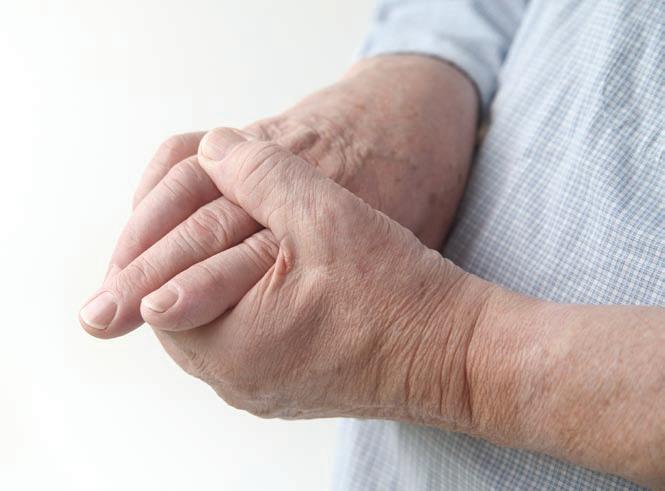
“Controlling arthritis is critical to diabetes management and vice versa,” says John H. Klippel, M.D., president and CEO of the Arthritis Foundation.
Staying active and at a healthy weight are key. Here are seven important facts that can help you manage both conditions to help you stay healthier.
Weight gain makes osteoarthritis worse. Because of body mechanics, every pound you gain over your ideal body weight can cause a force on your
hips and knees that’s four times greater. But even just a little weight loss goes a long way to reduce the wear and tear on those major weight-bearing joints. By losing just 10 pounds, for example, you’ll decrease the force on joints with each step by 40 pounds.
To reduce the risk of osteoarthritis, minimize pain, and help prevent the disease from progressing, keep your weight in check or lose weight if you need to by watching portion sizes and being as physically active as you can.
Age increases risk. The older you become, the greater your chances of developing osteoarthritis. The majority of people with osteoarthritis are over age 45. If you’re overweight, you’re at risk of developing the disease even earlier. You’re also more likely to get osteoarthritis if you injured a joint or if the



readers,
We wish to thank each of you for helping to make 50 plus Life a fun, interesting, and unique source of information and entertainment for our readers in central Pennsylvania.


Happy Holidays 1 in 5 adults is a caregiver. find all the local products and services You need for Your Journey. Features: • Informative Articles • Directory of Providers • Ancillary and Support Services View the 2022 edition online at www.BusinessWomanPA.com







No matter what your job is, chances are it involves at least some lifting. And as we get older, lifting becomes even more hazardous. Don’t take any risks with your back. Follow this advice from the Mayo Clinic:



Eat a healthy diet. Get enough calcium and vitamin D to prevent your bones from growing weak and brittle due to osteoporosis. Bone fractures can lead to back pain.
Exercise regularly. Combine walking or swimming with exercises that stretch and strengthen your back muscles, as well as tai chi and yoga to maintain your balance.
Watch your posture. Remember to balance your weight evenly on both feet when
disease runs in your family. Like diabetes, the tendency for osteoarthritis can be inherited.

Exercise reduces arthritis joint pain. Over time, physical activity actually reduces the pain of osteoarthritis surrounding an ailing joint and may be just as effective as taking pain medication.
That’s because stronger muscles protect joints by absorbing the force placed upon them. They also help hold joints in a better position so they don’t wear out as quickly.
Moreover, exercise helps keep your joints flexible. Focus on activities that strengthen the muscles surrounding an ailing joint, such as walking, swimming, and cycling, including using a stationary bike.
Besides bolstering your joints, regular exercise helps with weight and blood sugar control. Klippel recommends starting by walking for 30 minutes daily.
Too much exercise can worsen osteoarthritis symptoms. Don’t overdo it. Just like too little exercise, too much physical activity can make the disease worse.

To prevent overuse or further injury, monitor your pain level to avoid pushing yourself too hard. If it hurts to walk the day after taking a long hike, for example, take a break from walking that day but not from exercise.
Try swimming or cycling on a regular or a stationary bike. Both types of activity are joint friendly and can help you stay active consistently.
Osteoarthritis drugs won’t make your diabetes worse. To manage joint pain, ask your doctor about medication such as Tylenol (acetaminophen). It relieves pain, and the side effects are minimal.
If that doesn’t help, your doctor may recommend taking nonsteroidal antiinflammatory drugs (NSAIDS), such as Advil or Aleve. None of these common
standing, and don’t slouch. When sitting, choose a chair that supports your lower back, and adjust the height so your feet lie flat on the floor.
Practice proper lifting. Stand close to the object you’re lifting, bend your knees, and tighten your stomach muscles. Stand slowly, supporting your weight with your legs. Hold the object close to your body and maintain the curve of your back. Don’t twist while you’re lifting.
Pay attention to your body. Don’t lift if something hurts. If you’re sitting for a long time, shift position often, and take frequent breaks to walk around and stretch your muscles, reducing muscle tension.
pain relievers will affect your blood sugar, but be sure to take them as directed in the correct dosage to minimize or avoid side effects.
Worn-out joints can be replaced, but you’ll need to be fit for surgery. If X-rays show there’s little to no cartilage cushioning your joints — and everyday activities such as walking around the block or driving your car are extremely painful even with medication — you’re a contender for joint replacement (arthroplasty).
The surgery, which can replace worn-out hips, knees, and shoulders with a prosthetic, can make walking and more rigorous physical activity possible again and pain-free.
To be a candidate for this procedure, you’ll need to have your blood sugar under control. Managing blood sugar well will help reduce your risk of infection after the surgery.
Exercise before surgery is also important. Strong muscles can speed recovery from the operation so you can get back on your feet faster.


Much farmland in southeastern Pennsylvania is devoted to raising field corn. Cornfields are human-made habitats that have stages of succession, from bare ground to rows of tall corn plants, to short stubble after being harvested. And each stage is inhabited by certain adaptable kinds of wildlife.
Corn is planted in bare soil early in May. Killdeer plovers and horned larks are adapted to raising young on bare ground, or nearly so. Each female killdeer lays her four speckled eggs right on the soil.
But larks dig teacup-sized nurseries in bare ground, where each female deposits her eggs. Birds of both species are brown on top, which camouflages them against soil.
Some clutches of eggs are laid in rows of corn where they won’t be disturbed by cultivators trying to remove weeds. Nests between rows might be destroyed by cultivators.
The handsome killdeer and larks, and their eggs and chicks, blend into bare soil and are invisible until they move, which usually keeps them safe from

DATE: Sunday, January 15, 2023
RACE STA RT: 10 A .M.
LOC ATION: Lancaster County Central Park Pavilion 22 (Kiwanis Lodge)


Unique prizes and colorful ribbons will be awarded to the overall top three male and female finishers, the fastest runners in numerous age and gender categories, and the first three finishers (any age group) who race with dogs. There’ll also be door and dog prizes.
RACE FEES: $30 through January 5, 2023; and $35 from January 6, 2023, through race day (also the fee for race day walk-ins)
Beanies with the PB 5K logo are guaranteed for all those who preregister by January 5, 2023.
Proceeds benefit the Sierra Club – Lancaster Group’s green project grant • program, as well as its environmental cleanup and education efforts in Lancaster County.
hawks and other predators.

Baby killdeer are fluffy and hunt for invertebrate food soon after hatching. But lark chicks are born helpless and stay in their soil cradles for a couple of weeks. There they are fed invertebrates by both parents.
When fields of cornstalks are 8 and more feet tall, they look a little like woods or cattail marshes. They now offer food and shelter to a variety of adaptable wildlife. Elegant white-tailed deer and rascally raccoons ingest corn kernels while they are soft on the ears.
Grasshoppers eat the leaves of weeds and grasses on the sunny edges of cornfields. Butterflies, bees, and other insects sip the nectar of some weeds’ lovely flowers.
Field mice and groups of house sparrows feed on weed and grass seeds. Some of those mice, grasshoppers, and birds are caught and eaten by American kestrels, a type of hawk.
I’ve also seen post-breeding American robins and barn swallows flying into tall, sheltering cornfields at dusk. There they spend the night, as robins do in woods and swallows do in cattail marshes.
And I’ve seen a few lovely male indigo buntings singing in cornfields by late July, just as if they were establishing nesting territories in wooded thickets.
Corn is harvested in September, locally, leaving acres of short-stubble banquet tables. Attractive flocks of rock pigeons, mourning doves, Canada geese, mallard ducks, American crows, individual field mice, and other kinds of wild creatures feed on corn kernels lying on the ground among the stubble through autumn and winter.
Adaptable wildlife is interesting to experience in cornfields the year around, mainly because those species make use of human-made situations. The creatures have additional food and shelter sources, and we can enjoy experiencing them.
As the labor shortage continues to make hiring extremely challenging for businesses big and small, many companies have been reaching out to retirees to help ease the burden.
The Great Resignation has increasingly shed light on the value that older, experienced workers bring to the labor market.
However, there’s no denying that age bias is something older workers must contend with when applying for new jobs.
In February, ResumeBuilder.com surveyed 800 hiring managers in the U.S. to get a read on the amount of ageism present in the hiring process and found it actually affects young applicants as well as experienced.
The findings:
• 38% of hiring managers have caught themselves reviewing a resume with age bias.
• Close to half know of colleagues who are biased against applicants of a certain age.
• 41% say including a graduation year on your resume makes age bias more likely.
“Yes, there is age bias in hiring,” said Lori Rassas, author, attorney, and HR consultant.
“The good news is that we are making some progress in this regard, but the bad news is that it continues to be a loselose situation, as older candidates are being denied opportunities and employers are missing out on a pool of dedicated and talented candidates.”
When it comes to hiring both older and younger workers, the majority of survey respondents say they have concerns.
For applicants aged 60 and up, hiring managers say their main concerns are that the employee may retire not long after starting and that they may not be proficient in the technology needed to do the job.
“As much as age bias is still alive and well, this current marketplace is allowing older applicants to display that they are technically capable and adaptable as well as able to function well in a remote environment, as the interview process by Zoom meetings exemplifies their abilities, for example,” said career consultant Stacie Haller.
“Knowing what the bias may be, with preparing properly for the interview process and having collateral that removes the possibility of ageism bias, older and younger applicants can express during the interview process how they individually do not fit the stereotype of their cohorts and how and why they are the perfect candidate for the position,” she continued.
When considering hiring applicants who are younger than 25, hiring
managers have different concerns.
The main issues survey respondents were worried about with younger employees are that they’re likely to leave the job within a short period of time and that they lack the necessary experience to do the job well.
The survey asked hiring managers what applicants can do to avoid falling prey to age-based bias, and they had a few suggestions.
Forty-one percent said including a photo with your resume makes age bias more likely to occur, and an equal percentage also said including a graduation year could do the same. In fact, nearly 1 in 4 respondents say they would never recommend including graduation year on a resume.
However, the largest group of respondents (26%) says an applicant should always include all relevant work experience, even if it spans more than 25 years.


“The good news is there are many ways to diminish the bias of ageism, including the way your resume and LinkedIn profile are written and knowing how to overcome these unspoken objections,” added Haller.
“I agree that dates for education should not be included, especially on older applicants’ resumes, but feel strongly that experience over 20 years ago is also not applicable and not why the applicant would be considered for hire today.
“Many times, as in IT, for example, the workplace over 20 years ago does not resemble today’s world,” Haller continued. “There are ways to include this info without specific dates if it adds to their experience and value as a candidate.
“Other tips, like not using an AOL email address, and taking off the words ‘cell’ and ‘email,’ are a few examples of other ways to eliminate ageism on a resume,” she finished.
“Remember, everything you do in the job-search process — from selecting which opportunities to pursue, to drafting your cover letter and resume, to what you wear and how you behave in an interview — is geared toward eliminating any preconceived notions a prospective employer has about your age,” Rassas added.
“Is that unfair? Perhaps, but look at it this way: The more you do to dispel these preconceived notions, the more level the playing field becomes — and the less your age becomes a factor.”
To view the full report, visit resumebuilder.com/4-in-10-hiring-managersadmit-to-age-bia s

Model boats are decorated with brightly glimmering lights. Women sprinkle water scented with basil around their house, which they believe will keep bad spirits away. Families dine on spitroasted pork and fried pastry.


This is merry Christmas as it’s celebrated in Greece.
People around the world welcome this special day in a variety of ways, some familiar and others less so. These include festivities focused on Santa Claus and those that stress the Christ in the holiday’s name.
Given the seafaring history of Greece, it’s not surprising that decorated ships are an old tradition. In the past, small vessels were displayed in homes when sailors returned from sea voyages.
The kallikantzarol are described as roguish goblins that dwell underground
u Support the older person’s right to decide his/her own destiny. Encourage consumer self-determination and choice.
u Support the older person’s right to risk.
u Promote independence and dignity.
u Avoid unnecessary/inappropriate institutionalization.
and emerge during the 12 days of Christmas. While they have a reputation as naughty, some believers insist they’re actually impish and stupid.
Food often is a focus of Christmas merriment, and the list of typical fare is long and varied. Carp is the main dish at some holiday meals in Poland, and while some people buy a filet, others adhere to the timehonored way by purchasing the fish several days in advance, letting it swim in a bathtub, and then being dispatched when the time has come for it to be cooked and consumed.
Since Poland is largely a Catholic country, church attendance is part of the holiday observance for many people. Some also refrain from enjoying their favorite food and beverages in their effort to remember what they believe to
About Us – The Lancaster County Office of Aging (LCOA) was established 45 years ago as a result of the passage of the Older Americans Act. This act directed states to develop a network of services and supports to help keep older adults healthy and independent.
The Pennsylvania Department of Aging was created to fulfill this mandate. in turn, a network of 52 Area Agencies on Aging (AAA) was established throughout the commonwealth to carry out this mission at the local level.
Funding for aging-related services is a combination of state and federal monies, with the Pennsylvania Lottery providing the major source of funding. in Lancaster County, the AAA is part of county government. We are dedicated to providing Lancaster County residents, 60 years of age and older, with a wide range of informational resources and services as well as advocacy efforts and elder abuse protection. The
the real reason for Christmas.
Colonel Sanders would feel at home in Japan, where fried chicken at KFC and other fast-food restaurants is a holiday favorite. Other imports from the United States include exchanging cards and presents. Because most people are not Christian, Christmas in Japan is more like Valentine’s Day, a romantic time for couples to spend time together.

That contrasts with Germany, where the focus of celebration is the Advent; many families attend Mass on Dec. 24, and gifts are brought by the Christkind (child of Christ). Christmas trees have been used since the late Middle Ages. Most people have a real tree, which traditionally is decorated with wooden ornaments and real candles.
An impressive feature of holiday celebrations in Germany is the famous Christmas markets. Most cities have at least one, and some are based upon a theme, like angels or medieval times. The market in Frankfurt dates back to the 14th century, and the one in Cologne can attract more than 4 million visitors.
Some time-honored ways of celebrating Christmas were brought to Canada by German immigrants, along with people from France, Great Britain, Norway, and other countries. Given the cold winter climate, skiing, ice skating, and tobogganing are popular pastimes if the ground is covered by snow.

An annual extravaganza in Toronto is the Santa Claus Parade, which first took off in 1905 and now attracts more than a half-million people. Lavish floats, marchers, bands, clowns, and, of course, Santa and Mrs. Claus wind through the city along a 3.5-mile route.
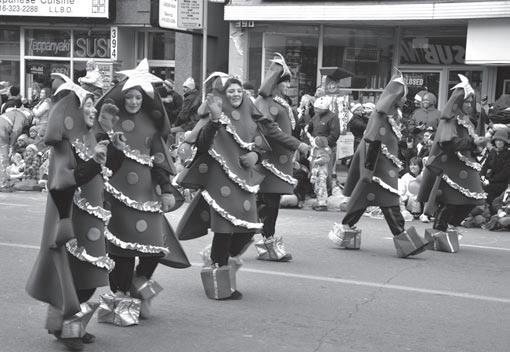
In contrast to the snow and shivering cold of Canada is warm winter weather south of the Equator. Of course, that includes Australia, where, as in other countries that previously formed the British Empire, some practices — like Boxing Day on Dec. 26 — take place.
Less familiar are the facts that Santa at times has been depicted as wearing Australian-style clothing, including a wide-brimmed Akubra hat and flipflops, and riding in a sort of pickup truck pulled by kangaroos. Some Aussies go to a beach to swim in the ocean, and it’s not unknown for Santa to come ashore riding a surfboard.
Argentina and South Africa share a Southern Hemisphere location with Australia, so sand and surf are more closely associated with Christmas than snow and sleet. Santas dressed in their traditional wool clothing do their best to keep shouting ho-ho-ho when they’d prefer to say hot-hot-hot.
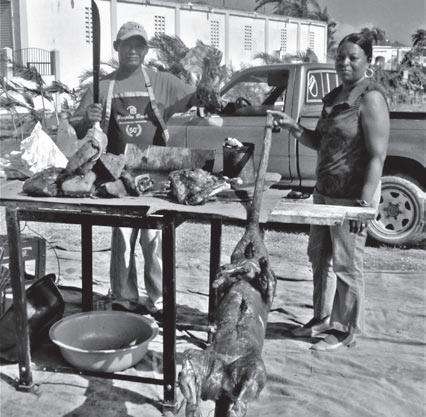

Argentinians are lovers of meat, so it’s no surprise that an outdoor barbecue is a staple of activities. So are Christmas trees, usually artificial and sometimes decorated with cotton
balls to represent snow. Fireworks at midnight often mark the start of Christmas Day, and the sky is filled with globos, paper decorations with a light inside that float into the sky.
Dining outside also is a highlight of Christmas in South Africa. The main course might be turkey, duck, or suckling pig, followed by a desert of malva pudding, a sweet cake prepared with apricot jam and vinegar, which gives it a caramelized texture.
Some activities, like trimming a Christmas tree and hanging stockings, may sound familiar. Depending upon where you live in the United States, outdoor activities like beach sunbathing, hiking in a park, or camping may be less likely.
A fter gallivanting around the world, Victor Block still retains the travel bug. He believes that travel is the best possible education. A member of the Society of American Travel Writers, Victor loves to explore new destinations and cultures, and his stories about them have won a number of writing awards.
It’s a few minutes before 7 a.m., and the sun is rising outside when 94year-old Jay Rentzel guides his lanky frame down the ladder into the York YMCA natatorium. The 85-degree water welcomes him to the start of another day.
The familiar greeting brings a smile to Rentzel’s face as he takes his position along the wall in lane six. Over the next few minutes, he’s joined by four other seniors, ranging in age from 73 to 91.
With lap swimmers churning the water in lanes one through four, Rentzel begins the water aerobics exercise class with a series of leg kicks.
Rentzel has led the Monday-through-Friday class, which varies from four to 10 participants, as a volunteer for more than 30 years.
“We’re in constant motion for the full hour,” says Rentzel, who drives 8 miles from his home in Manchester to the York YMCA. “We don’t rest in between exercises.”
Janice Vaughn, 73, of Dallastown, says, “Jay’s commitment is amazing. And, his vitality and enthusiasm are impressive. He keeps us moving the entire time.”
Rose Smith, 91, of York, adds: “Jay does a great job of leading the group. He’s a motivational instructor.”
The class consists of 32 exercises, including walking around the pool (forward, backward, and sideways), flutter kicks, side bends, running in place, arm circles, pushups against the wall, and more.

Rentzel, a 50-year member of the York YMCA, enjoys starting the day with exercise.


“It helps me physically and mentally,” he says. “I’m much more productive during the day because of it.”
He says water aerobics improves his flexibility and increases his strength and endurance.

“If I didn’t exercise, I wouldn’t be able to be as active as I am,” he says.
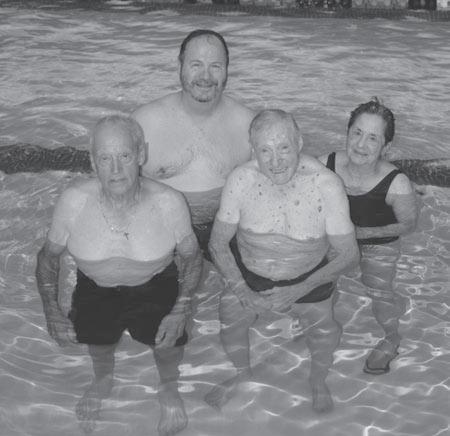
Social Security and Supplemental Security Income benefits for approximately 70 million Americans will increase 8.7% in 2023, the Social Security Administration announced recently.
On average, Social Security benefits will increase by more than $140 per month starting in January. This is the largest costof-living adjustment increase since 1981.
The 8.7% COLA will begin with benefits payable to more than 65 million Social Security beneficiaries in January 2023. Increased payments to more than 7 million SSI beneficiaries will begin on Dec. 30, 2022. (Note: some people receive both Social Security and SSI benefits.)
The Social Security Act ties the annual COLA to the increase in the Consumer Price Index as determined by the Department of Labor’s Bureau of Labor Statistics.
“Medicare premiums are going down, and Social Security benefits are going up in 2023, which will give seniors more peace of mind and breathing room,” Acting Commissioner Kilolo Kijakazi said.
Rentzel’s sentiments are shared by other class members.
“I look forward to the class,” says Jim Fink, 87, of Manchester Township. “It gets me going in the morning. The class helps increase my leg strength.”
“The class has definitely improved my flexibility,” offers Vaughn, who suffers from arthritis. “I feel much stiffer on days I don’t attend.”
Her husband, Patrick, believes the 7 a.m. routine helped him recover more rapidly from a recent fall.
According to the national YMCA, regular participation in water aerobics can improve heart health and cardiovascular strength. The water’s pressure helps circulate the blood in your body more efficiently.
As your heart continues beating and pumping with less strain and pressure over time, you effectively lower your risk of heart disease. Water exercises have been shown to help lower high blood pressure.
Exercising in the water is a great way to burn calories and better tone your muscles. The natural buoyancy of water creates a sense of weightlessness, reducing the impact typically experienced during a more traditional workout. Water exercises are ideal for those who suffer from joint pain or other degenerative body conditions.
Besides the physical benefits of the class, there’s a palpable camaraderie.
“It’s more fun to exercise with others,” says Vaughn. “It motivates you more. You get to know the people in the class.”
But Smith says it’s no social hour.
“You’re constantly moving,” she stresses. “The focus is on exercise. There’s time to talk afterward.”

When Rentzel retired from Hajoca, a wholesale plumbing and heating distributor, in 1991, he vowed to keep busy. He has kept that pledge.
He has always been athletic. Rentzel played baseball and soccer in high school and played basketball for the Manchester Athletic Association.
Besides his daily water aerobics, Rentzel participates in three golf leagues
“This year’s substantial Social Security cost-of-living adjustment is the first time in over a decade that Medicare premiums are not rising and shows that we can provide more support to older Americans who count on the benefits they have earned.”

Increases in VA disability are directly correlated with the COLA increase. More than 5 million veterans can expect an increase in VA disability that ranges from $13.28 at 10% disability to $298.89 for 100% disability.
Those numbers only reflect single veterans. VA’s official compensation tables for veterans at 30% disability or higher who have dependents added to VA disability will be released in December.
Social Security and SSI beneficiaries are normally notified by mail starting in early December about their new benefit amount. The fastest way to find out their new benefit amount is to access their personal “my Social Security” account at ssa.gov/myaccount.

and bowls in a senior league. He plays in a nine-hole league every other Thursday and a nine-hole league once a month.
Every Wednesday, he tees off in an 18-hole league.
“I can shoot my age,” says Rentzel, proudly. “I really enjoy being on the golf course.”
When Rentzel isn’t golfing, you can find him at the bowling center. He bowls in a league from late August through mid-April and averages around 150.
A lifelong baseball fan, Rentzel follows the Baltimore Orioles. He has been treasurer of the Old Timers Association of the Central York County Baseball League since 1986.
Rentzel’s advice to other seniors is it’s never too late to start exercising.
“If you start exercising, you won’t be sorry,” he says. “It makes you feel good, and you’ll want to keep doing it. Exercise can be very infectious. There are a lot of exercises you can easily do in the water that you might have trouble doing out of it. Water aerobics helps alleviate aches and pains.”
Rentzel doesn’t have any plans to stop leading the water aerobics class, playing golf, or bowling.
“I’ll do everything as long as I can,” he says.
As the class winds down, Rentzel leads the participants in the traditional finale.
“I feel great. I feel great. I feel great. I feel fantastic,” the group shouts in unison.
It’s a fitting end to a productive hour. With that, class members scatter from the pool, ready for another day.
Life expectancy is one of the most important and commonly cited indicators of population health — and in the United States, life expectancy is falling at a historic rate.

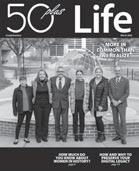
According to the Centers for Disease Control and Prevention, life expectancy at birth declined by 1.5 years in 2020, the largest oneyear decline since World War II.
The CDC attributes the decline to the COVID-19 pandemic and 93,000 drug overdose deaths — an all-time one-year high. Homicide, diabetes, and liver disease were also contributing factors.
While the national trend is alarming, there are considerable regional variations in life expectancy across the country.
As of 2019, the most recent available year of state-level data, life expectancy at birth in Pennsylvania is 78.5 years, the 32nd highest among states and slightly lower than the comparable national average of 79.2 years.
Both at individual and population levels, life expectancy is closely linked to certain behavioral factors.
For example, smoking is the leading cause of death in the United States, and adults in Pennsylvania are more likely to smoke than average. An estimated 17.9% of the 18-and-older population in the state are smokers — meaning they smoke every day or most days and have smoked at least 100 cigarettes in their lifetime.
Nationwide, 16.6% of the adult population are smokers.
Data on average life expectancy at birth is from the Robert Wood Johnson Foundation and the University of Wisconsin Population Health Institute joint program’s 2021 County Health Rankings & Roadmaps report.
Additional data is from both CHR and the U.S. Census Bureau’s 2019 American Community Survey.

rank State Life expectancy at birth (yrs.)


Adults who smoke (%) Median household income ($)
1 Hawaii 82.3 14.4 83,102 2 California 81.7 11.5 80,440 3 new york 81.4 13.0 72,108 4 Connecticut 80.9 12.5 78,833 4 Minnesota 80.9 15.5 74,593 6 Massachusetts 80.6 13.7 85,843 6 Colorado 80.6 14.7 77,127 8 new Jersey 80.5 13.2 85,751 9 Washington 80.4 12.1 78,687 10 Florida 80.2 14.9 59,227 11 utah 80.1 9.1 75,780 12 Arizona 80.0 14.5 62,055 13 Oregon 79.9 15.7 67,058 14 Rhode Island 79.8 15.2 71,169 14 Vermont 79.8 14.7 63,001 16 north Dakota 79.7 19.7 64,577 16 new Hampshire 79.7 16.6 77,933 18 nebraska 79.6 16.6 63,229 18 Virginia 79.6 15.1 76,456 20 Wisconsin 79.5 17.2 64,168 21 Illinois 79.4 15.9 69,187 21 Idaho 79.4 15.0 60,999 21 Iowa 79.4 17.4 61,691 24 Texas 79.2 14.2 64,034 24 Maryland 79.2 12.6 86,738 26 Alaska 79.0 18.5 75,463 27 Montana 78.9 18.9 57,153 27 South Dakota 78.9 20.2 59,533 27 Wyoming 78.9 19.2 65,003 30 nevada 78.7 15.7 63,276 30 Maine 78.7 19.4 58,924 32 Pennsylvania 78.5 17.9 63,463 32 Kansas 78.5 17.9 62,087 32 Delaware 78.5 17.4 70,176 35 north Carolina 78.1 17.9 57,341 35 Michigan 78.1 20.1 59,584
new Mexico 78.0 15.9 51,945 38 Georgia 77.9 16.3 61,980
Missouri 77.3 20.1 57,409
South Carolina 77.1 18.7 56,227
Indiana 77.1 21.7 57,603
Ohio 77.0 21.4 58,642
Louisiana 76.1 21.1 51,073
Arkansas 76.1 23.7 48,952

Oklahoma 76.1 19.9 54,449

Tennessee 76.0 20.8 56,071
Kentucky 75.6 24.1 52,295
Alabama 75.6 20.0 51,734
Mississippi 74.9 21.0 45,792
West Virginia 74.8 26.9 48,850
You walked into the party like you were walking onto a yacht
Your hat strategically dipped below one eye, your scarf it was apricot
You had one eye in the mirror as you watched yourself gavotte
And all the girls dreamed that they’d be your partner, they’d be your partner
And you’re so vain, you probably think this song is about you Don’t you, don’t you?
Some lyrics of Carly Simon’s No. 1 hit often left many music fans scratching their heads in wonder. Let’s start with the little-known word gavotte.
“A gavotte is a French dance,” Simon explains. “I thought I would use a word that was slightly presumptuous … He’s gavotting because that’s what a pretentious, vain man would do.”
Then there is that mysterious line, “There were clouds in my coffee.” That statement came about during a flight Simon took with her piano player, Billy Merritt.
She explains, “As I got my coffee, Billy said to me, ‘Look at the clouds in your coffee.’ There were clouds outside the window of the airplane, and you could see the reflection in a cup of coffee.” (And we were supposed to figure this out?)
By Carly Simon December 1972

But the question that most fans asked was: Who was Simon ridiculing in “You’re So Vain,” an Elektra Records tune that topped the Billboard singles chart for three weeks in the waning days of 1972?

That hit, whose creation consumed nearly a year of Simon’s time, came from her third LP, No Secrets, a No. 1 Billboard album for over a month.
Simon claims that “You’re So Vain” actually refers to a total of three
famous, arrogant individuals. She has stated that ex-husband James Taylor and Rolling Stone Mick Jagger are definitely not the men she had in mind when she put pen to paper many years ago.

Other possible candidates — deep breath here — have included David Bowie, Cat Stevens, Kris Kristofferson, David Cassidy, and Jack Nicholson.
“I was brought up by a mother who was adamant that you didn’t even kiss a man until you were in love with him,” Simon has admitted. “So I was in love with a lot of men. I was besotted by the lads! I was definitely a romantic.”
Recently, Simon admitted that the second verse was about actor Warren Beatty — but only the second verse.
You had me several years ago, when I was still quite naïve
Well, you said that we made such a pretty pair and that you would never leave
But you gave away the things you loved, and one of them was me
I had some dreams, they were clouds in my coffee, clouds in my coffee
In August 2003, she agreed to reveal the unknown names to the highest bidder of a Martha’s Vineyard charity auction. Dick Ebersole, the head of NBC Sports, won with a bid of $50,000, but he had to agree to never reveal what she told him.
And so, to this day, Carly Simon’s mystery men have remained a mystery.
Randal C. Hill is a rock ’n’ roll historian who lives at the Oregon coast. He may be reached at wryterhill@msn.com.

“You’re So Vain”
Taking steps to reduce our negative impact on the earth is a year-round job. But it can seem much harder during the winter season. Cold weather and long, dark nights, along with holiday celebrations, make it challenging to prioritize planet-healthy habits.
Still, there are ways to reduce our impact for a more sustainable planet. So follow these tips to keep your winter — and our world — green!

One thing people struggle with most during winter is the chilly temperatures. As the weather gets colder, it’s tempting to crank up the thermostat.
But overusing your heater consumes a lot of energy. Depending on the size of your home, you’re likely warming up areas that aren’t even being used.
Before you turn up the thermostat, add some layers of clothing, socks, and warm fuzzy slippers. It may be enough to keep you warm and comfy. If you’re just relaxing, get cozy and cuddle up under a blanket with warm food and a hot drink.
Getting a smart thermostat is also a smart investment, which will pay for





itself in a relatively short time. There are many brands available that offer features to help you stay eco-friendly.
These include timers to set specific temperatures for when you’re at home, away, or sleeping. There are also recommended ecofriendly temperature settings and even the ability to control the thermostat from your phone.
Starting a fire in your fireplace can be a fun heat alternative for winter. It gives off heat in a smaller, concentrated space and uses less energy than a furnace. If you have a wood-burning fireplace, be sure to have your chimney cleaned and inspected annually for fire safety.
With the sun setting earlier and more gray days, it’s tempting to switch on a lot of extra lights. But lights also use a lot of energy.
So make a conscious effort to turn off lights when you leave a room (unless you’ll be returning in a reasonably short time), and only use the lights you need.
Another way to cut back on energy use from lights is to switch to LED or CFL bulbs, which are more energy efficient. Also, consider lights with dimmer switches. There are lights with sensors that turn them off automatically when
there’s no movement in the room for a set amount of time, as well.
Another fun alternative is to use candles, which also add ambiance. Just make sure they’re eco-friendly! Also, if you have pets or young children, they should be kept in a high, secure spot to reduce the risk of injury or fire.
Conserving on electrical lights also goes for outdoor holiday lights. These lights use a lot of energy. So consider more earth-friendly options. Holiday lights with LED bulbs and solar-powered outdoor lights are better for the planet and your wallet. You can also use timers for outdoor decorations, so you don’t have to worry about remembering to turn them off.
A big highlight of winter is holidays and get-togethers with gift exchanges. But all the gift-giving leads to a lot of waste and overconsumption of goods. The best option is to eliminate gift exchanges. Instead, make the holidays special by focusing more on fun activities and quality time with family and friends.

But there are many ways to go green, even with gifts. Doing so is also an excellent opportunity to share environmentally friendly practices with your loved ones.
A few ideas for green gifting include:
• Give experiences instead of things.
• Do a White Elephant or Secret Santa exchange where each person gifts one item.
• Look for gifts at secondhand or thrift stores (if everyone can agree to this, no one will feel like a cheapskate).
• Gift eco-friendly products like reusable straws or mugs.
• Choose wooden toys over plastic.
• Shop locally from small businesses.
Green gift wrap – Once you’ve found the perfect gifts, get creative with wrapping! Traditional wrapping paper is typically used once and then discarded, which consumes more resources.
Some alternatives are to reuse old wrapping paper; repurpose other products, like newspaper or paper bags from the grocery store (some stores even have themed bags during the winter); or look for gift bags that can be reused (nice fabric ones, such as reusable tote bags, can be passed along for years to come).
Small changes to your winter routines can help you stick to your values and reduce your consumption of the planet’s resources. So look for opportunities to reduce, reuse, and recycle throughout the winter months to help keep our earth evergreen.
Kimberly Blaker is a freelance writer. She also owns an online bookshop, Sage Rare & Collectible Books, specializing in out-of-print, scarce, signed, and first editions; fine bindings; ephemera; and more.
Affordable housing for those 62 and older, located in beautiful, historic Marietta

Rents start at $846 and include all utilities (heat, electric, water, sewer, trash), off-street parking, on-site laundry, community room, and community garden. Two-bedrooms start at $1,015.
For applications and information, please contact: Community Basics, Inc. 717-735-9590 or info@communitybasics.com
Villages at Greenfield (formerly Eastwood Village) offers:

Land Lease Community

High-quality manufactured homes on foundations
Covered Front Porches
Energy Star Certified
Landscape package included
Optional Garage / Storage Shed
Natural Gas Community
Public Water and Sewer

Model homes available to tour.
Professionally managed by




